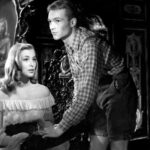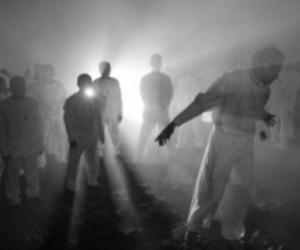To Overcome the trouble of youth
Reflecting on Marianne de ma Jeunesse (1955) by Julien Duvivier
I am referring here to the French version of the film, starring Pierre Vanick as „Vincent Loringer“. At the same time a German version was shot with Horst Buchholz in that role and an otherwise identical cast. Despite its ambitious launch in Paris (18 March 1955) and Cologne (8 April 1955), the film was unfortunately not a great commercial success. It was too stubborn and formally ahead of its time, just like Max Ophuls'(s) Lola Montes (1955). Ophuls’ son Marcel served as assistant director for the German actress Marianne Hold.
«I can hear your voice, Vincent.»
The author Peter de Mendelssohn (1908-1982), primarily known today as a great newspaper man after the Second World War and as Thomas Mann’s biographer, thus provided at the end of the Weimar Republic the invention of a generation in constant motion which does not easily find itself. His fictional characters hardly find any rest. These urbanites are constantly on the move and away from home. They drive cars or use trains, buses or aircraft and communicate day and night over power lines. Without a telephone, notes the narrator, “your best friend in Berlin soon disappears from your view, and you forget him or her altogether”.
The central character of his novel Painful Arcadia, Oswald Laengfeldt, eighteen-year-old, has just finished high school when he comes into this world of fluctuation and insubstantiality. Oswald gets a job writing a serial for a “major newspaper” in Berlin, and the competition in there, the incessant pressure to perform, his personal feelings of uncertainty and his desire to be creative, which is only partially fulfilled. Oswald runs literally from one crisis to the next. Berlin serves as a symbol of “intellectual corruption” par excellence, especially for a young scribbler faced with a constant lack of money. In the “rudest city that you can imagine”, financial problems and writing are inseparable. The mere bulk of print remains impressive: around 1930, in addition to well over 100 political newspapers, there are still 45 morning newspapers, 14 weekly newspapers and two evening newspapers. Neither these circumstances, described by Mendelssohn much later in his great history of journalism Zeitungsstadt Berlin (1959), nor the political turmoil teach the reader anything. It is essentially about the amount of discarded articles, hardly ever about their contents. Mendelssohn’s novel reflects the „zeitläufte“ only learnt through the bullying of careerists or freelancers who, day after day, besiege the editors to accommodate an article.
Oswald’s movements of thought gradually get to resemble the mechanics of composing machines in this environment: “I hate the unnatural pace,” he complains, “the superfluous rat race that allows any man of sense to carry a thought to an end because it began as early as the Linotype did.” Mendelssohn knows what he speaks of. At the start of his career,he threw one book after the other on the market at an incredible rate, and with some success. His debut in 1930 was followed by the second novel Paris Over Me and in 1932, the third, Painful Arcadia.
«So you’re the one who had to come for me.»
Mendelssohn was then working full-time as editor of the Berliner Tageblatt, before he fled to England from the Nazis in 1933. His prose bears quite novel traces of that “German newspaper style” of the Weimar Republic, “with all its sloppiness, all that dilettantism and strange coincidence” that one critic complained about in 1926. You can see that in the very first sentence of the novel: “It is an attempt to describe the overcoming of the difficulties of youth.” („Es ist dies ein Versuch die Schwierigkeiten der Jugend zu überwinden.“) That stilted German formulation clearly marks the desire for a certain artistic design and holds a passive but responsible quality. The narrator brings it here to validity and at the same time, just behind an impersonal “it”, he ducks away, about a youth in a “serialistic age” who demands personal commitment, but has no chance of success for this: “This life that is lived on credit in the literal and figurative sense”, so Mendelssohn played by different scenarios: First, there is Manfred Vellin, a talented, complex personality, who pursues Oswald in a kind of intimate love-hate relationship. Then Manfred, in turn, develops an unfortunate passion with Franziska von Burkom, a successful actress. With her, Oswald has to start an affair and realizes all the problems men and women can (possibly) have when domineering is no longer the first of a man’s duties, but empathy still does not quite work out. Then Franziska Oswald joins Ellen Duvernon and Ruth Friedland. Ellen represents the new type of successful woman, who overwhelmed the men of the twenties hopelessly.
This time, Oswald does not fail from selfish impatience, but capitulates to the ambition and energy of the work of her partner. Ruth, however, is in need of help and thus comforts the male self-esteem. But that goes well only in rare moments, because it represents the ruined educated middle class. These various women do not prepare Oswald for individual personality problems. Rather, they seem to him just like “any women”. “Of course it is nonsense to believe that any men belong together,” says one of his friends, “every five minutes, bang, bang, and gather around anything.”
So we have, for example, the meeting of the eighteen-year old Peter von Mendelssohn, who was born in Munich and grew up in Hellerau, a suburb of the city of Dresden, with that Berlin banker’s daughter and drama student who has become the archetype of the “Marianne de ma jeunesse”. As that three-hundredth anniversary of the town of Brandenburg was going to be celebrated those families both hospitable and bohemian in their way of life. But then the years from 1927 on had shown its impossibility in the social whirl of Berlin, so that the Strausbergerplatz summer idyll in the wistful recollection of a “painful Arcadia” was the brightly burning, very youthful love of the “Arcadians”.
«I will hurt you deeply, Argentin!»
Then, when the plan of this book in the very first stage alone was conceived, it was further developed by the impulsive Reclam (the famous German publisher) lecturer Ernst Sander (1898-1976) into a real job for the nineteen-year-olds. And so it evolved in a haphazard way. Sander required changes, then in 1932 Mendelssohn wrote a second version, the one not only acquired by the “naval officer publisher” Wolfgang Krüger, but also sold by him at once to Paris, and emigrated at the dawn of the Third Reich. Krüger left him both halves of the fee for the French translation.
But then, it was precisely the French translation of 1933 which drew attention from the man who was Duvivier’s artistic assistant in those days, André Daven (1899-1981). He suggested the book to Duvivier in 1954, when his plan to bring Alain-Fournier’s Le Grand Meaulnes to the screen failed because of the opposition of Alain-Fournier’s sister. That’s how the famous telephone call for Mendelssohn from Paris came about, and in a few months, the Franco-German co-production Marianne de ma Jeunesse – and then finally the re-encounter with the archetype of „Marianne“ came to a painful Arcadian end.
This international bustle is no accident. Some of the influential movie people like Berolina production chief Kurt Ulrich from Berlin quickly insisted on touting out the German heath and native soil. With such new claims, the costs of dream factories grew. The actors were demanding steep fees. Similar phenomena had also begun in France, Italy and England – even if the causes were different. Everywhere money was lost in the national film industry. At first, they helped with purely protective measures. The American offer was restricted by quotas and production freely fought through coercive rates in the cinemas of “living space”.
Let us turn to the movie again for a few seconds: Vincent tells Manfred what happened in the Manor. He meets a beautiful young lady called Marianne who seems to be a kind of prisoner to a man she calls the Knight. She says she has been expecting Vincent for a long time. “So you’re the one who had to come for me” … At one moment she suddenly leaves Vincent because she can hear the Knight calling her with his walking stick. When she’s back she finds Vincent asleep and explains she was forced to sit next by the Knight until he fell asleep because he was constantly grabbing her hand. A storm comes up, written into the amazingly brutal but tender score of Belgian composer Jacques Ibert (1890-1962). Marianne asks the butler for the boat and they drive him back. Later the Knight will explain to Vincent that Marianne is suffering from a mental disease that began after she was abandoned two years ago by her lover, on the very day they were supposed to get married. And the so-called forthcoming marriage ceremony is, in fact, a shock therapy that might cure her: “Maybe one day, when she heals, she’ll meet you again.”
«In a house whose shadow extends across three frontiers.»
A film like a poem – committed to all that youthful pathos and symbolism, but also repeatedly penetrated by a hint of delicate irony, including a breathtaking cinematography by Leonce Henri Burel, Eugen Schüftan and George Krause. However, the protective quotas alone did not cut it alone in France, Italy and England. In this dilemma the magic word was born: “co-production”. It arose from the simple consideration that if a purely French film in France and a purely Italian film in Italy brought back only 60 percent of their costs on average, then a French-Italian film could bring about a 20 percent gain in both countries. The perfection of the modern dubbing systems and the general audience’s being used to dubbed films let the language barrier quickly fade into the background. In those years, some 100 Italian-French movies were produced, including major hits such as Don Camillo (1952, by Julien Duvivier) and Lucrezia Borgia (1953, by Christian-Jaque). The celluloid connection of the two countries, however, was facilitated by their almost similar „public“ mentality.





